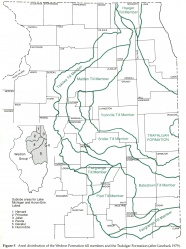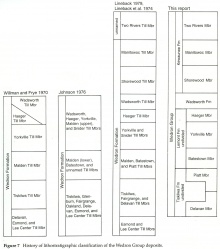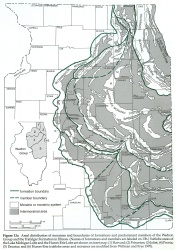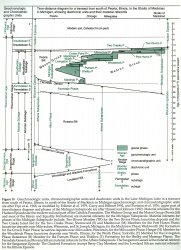Piatt Member
Lithostratigraphy: Wedron Group >>Tiskilwa Formation >>Piatt Member
Chronostratigraphy: Cenozoic Erathem >>Quaternary System >>Pleistocene Series
Primary source
Hansel, Ardith K., and W. Hilton Johnson, 1996, Wedron and Mason Groups: Lithostratigraphic Reclassification of Deposits of the Wisconsin Episode, Lake Michigan Lobe Area: Illinois State Geological Survey Bulletin 104, 116 p.
Contributing author(s)
Ardith K. Hansel and W. Hilton Johnson
Name
Original description
Piatt Till Member (Wickham 1979a).
Derivation
Piatt, a county in east-central Illinois.
Other names
History/background
The Piatt Till Member of the Wedron Formation was defined by Wickham (1979a) in Champaign County. It was described as sandier and more illitic than the underlying Fairgrange Member of the Wedron Formation, which is classified as the Delavan Member of the Tiskilwa Formation in this report. The Piatt Till Member was previously identified as unit 3 in McLean County by Kempton et al. (1971), an unnamed till in Coles County by Ford (1973), and an unnamed sandy till in the northern portions of De Witt and Piatt Counties by Johnson (1976). The Piatt Till Member was mapped as the surface till in Piatt, Moultrie, western Champaign, western Douglas, northeastern Shelby, eastern Macon, eastern De Witt, and southeastern McLean Counties on the state Quaternary map (Lineback 1979; fig. 5). Although similar to diamicton of the overlying Batestown Till Member described by Johnson et al. (1971b) in the Danville area, diamicton of the Piatt Till Member generally contains more sand, has less illite in the clay-size fraction, and sometimes exhibits a pink or violet cast (Wickham 1979a).
Because of its similarity to the Batestown Till Member, the Piatt Till Member was grouped by Johnson (1976) and Lineback (1979) with the middle, medium textured tills of the Wedron Formation. In this report, however, the Piatt Member is classified with the group of medium textured diamicton units included in the Tiskilwa Formation (fig. 7). Like the Delavan Member, the Piatt Member appears to be a grayer, lithologic variant of type-Tiskilwa diamicton, but it still contains some of the red distinctive of the Tiskilwa Formation. It also has lateral continuity with the other portions of the Tiskilwa Formation around the Lake Michigan Lobe area (fig. 13). The Delavan-Piatt Member contact in places appears to be conformable and gradational (i. e., the two members are part of the same glacigenic sequence), suggesting a change in source during the glaciation. As discussed in the introduction, wherever possible we have attempted to place strarigraphic boundaries between formations where lithologic changes correspond with those separating glacigenic sequences.
|
Type section
Type location
Mahomet Interstate 74 Bridge Section along the Sangamon River.
Type author(s)
Type status
Overgrown and poorly exposed.
Reference section
Reference location
Mahomet North Section; good for lower boundary and lithology. Core 4943; good for lithology and contacts. Wedron Section; good for lithology and contacts.
Reference author(s)
Reference status
Stratigraphic relationships
The Piatt Member is the upper gray, loam diamicton facies of the Tiskilwa Formation. It occurs above part of the Delavan Member in the Decatur Sublobe area and locally above the undivided Tiskilwa Formation elsewhere. The Piatt Member sometimes has a pink or violet cast and oxidizes to light brown or slightly orange.
Diamicton of the Piatt Member is sandier, more illitic, and grayer than that of the underlying Delavan Member, but the contact between these members, especially in the Piatt Member's southern area of occurrence, is often conformable and gradational over about a 0.5-meter zone and thus difficult to delineate in the field. Arbitrary vertical boundaries may be necessary in these areas to laterally separate the Piatt and Delavan Members (see Delavan discussion). Diamicton of the Piatt Member sometimes is difficult to differentiate from that of the overlying Batestown Member, but generally it is both less silty and less illitic. It sometimes exhibits a pink or violet cast and oxidizes to a slightly orange, whereas diamicton of the Batestown Member is grayer and more likely to weather to olive brown. For mapping purposes, a vertical boundary at the Champaign, Pesotum, and Arcola Moraines is recommended (fig. 13).
Extent and thickness
The Piatt Member forms an upper wedge-shaped deposit over part of the Delavan Member in the Decatur Sublobe area, where it pinches out beneath the Batestown Member to the northeast (fig. 13). The southwestern front of the deposit follows a distinct protrusion of the Shelbyville Moraine to the southwest. The Piatt Member is up to about 20 meters (66 ft) thick in some parts of Champaign County (as shown in Wickham 1979a).
Lithology
The Piatt Member consists of gray, loam diamicton containing lenses of sorted sediment. It sometimes has a pink or violet cast and oxidizes to brown, yellow brown, or orange brown, depending on its original color. Diamicton texture may vary, especially near the surface, where locally it is interbedded with stratified sediment.
Core(s)
Photograph(s)
Contacts
Lower boundary: the contact with the Delavan Member or the undivided Tiskilwa Formation. Upper contact: the contact with the Batestown Member (Lemont Formation), upper tongues of the Peoria Silt and the Henry and Equality Formations, or postglacial units.
Well log characteristics
Fossils
Age and correlation
The Piatt Member was deposited during the Shelby Phase of the Michigan Subepisode, probably between about 19,000 and 18,500 radiocarbon years ago (Hansel and Johnson 1992; fig. 10). It likely correlates with the upper grayer facies of the undivided Tiskilwa Formation in some areas of Illinois.
|
Environments of deposition
The Piatt Member consists of till and ice-marginal, redeposited sediment. Locally, it appears to be part of the same glacigenic sequence as the Delavan Member; in these places a conformable contact between the Piatt and Delavan Members suggests that the two tills were deposited during a single glacial event.
Economic importance
Remarks
Reclassified unit. Name changed to the Piatt Member, and unit classified as part of the Tiskilwa Formation. Formerly classified as the Piatt Till Member of the Wedron Formation (Wickham 1979a).
References
FORD, J., 1973, Surficial Deposits of Coles County, Illinois: Illinois State Geological Survey Open File Report, 73 p.
HANSEL, A. K., and W. H. JOHNSON, 1992, Fluctuations of the Lake Michigan Lobe during the late Wisconsin Subepisode: Sveriges Geologiska Undersokning, Series Ca 81, p. 133-144.
JOHNSON, W. H., 1976, Quaternary stratigraphy in Illinois— Status and current problems, in W. C. Mahaney, editor, Quaternary Stratigraphy of North America: Dowden, Hutchinson, & Ross, Inc., Stroudsburg, PA, p. 169- 196.
JOHNSON, W. H., D. L. GROSS, and S. R. MORAN, 1971b, Till stratigraphy of the Danville region, east-central Illinois, in R. P. Goldthwait, J. L. Forsyth, D. L. Gross, and F. Pessl, Jr., editors, Till, A Symposium: Ohio State University Press, Columbus, p. 184-216.
KEMPTON, J. P., P. B. DuMONTELLE, and H. D. GLASS, 1971, Subsurface stratigraphy of the Woodfordian tills in the McLean County region, Illinois, in R. P Goldthwait, J. L. Forsyth, D. L. Gross, and F. Pessl, Jr., editors, Till, A Symposium: Ohio State University Press, Columbus, p. 217-233.
LINEBACK, J. A., 1979, Quaternary Deposits of Illinois (Map): Illinois State Geological Survey, scale 1:500,000.
WICKHAM, J. T., 1979a, Glacial Geology of North-Central and Western Champaign County, Illinois: Illinois State Geological Survey Circular 506, 30 p.
ISGS Codes
| Stratigraphic Code | Geo Unit Designation |
|---|---|




